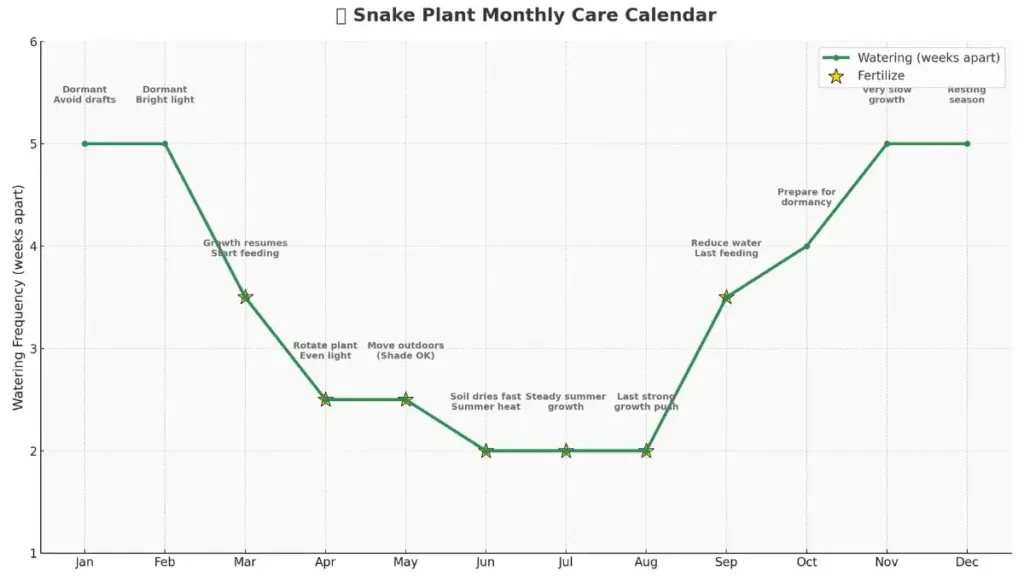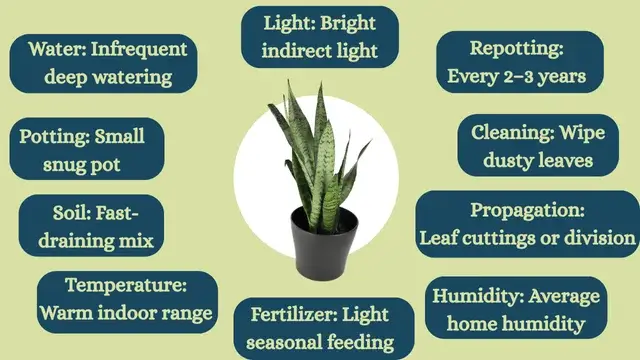Snake Plant Care Made Simple — Proven Tips for Watering, Light & Propagation

The snake plant (Dracaena trifasciata, formerly Sansevieria) is not just famously indestructible—it’s been named the 2025 Plant of the Year! This honor, awarded by horticultural experts, highlights its perfect blend of resilience, beauty, and symbolic meaning (especially fitting for the Year of the Snake).
But what does it take to help your award-winning plant truly thrive? This 2025 Ultimate Guide is your complete reference, drawing on the latest expert advice from NASA studies to veteran horticulturalists.
We cover every aspect of snake plant care—from the perfect light and water schedule to advanced propagation techniques—so you can enjoy your resilient, air-purifying companion for decades to come.
Native to West Africa, this plant (also known as Mother-in-Law’s Tongue) has adapted to survive dry conditions, making it perfect for busy plant owners. Its upright, architectural leaves are not just beautiful—they’re functional air purifiers.
Quick Answer: Snake plant care essentials: Place in bright, indirect light, water only when the soil is completely dry 2-3 inches down (typically every two weeks in summer), use well-draining succulent soil, maintain 65-80°F temperatures, and fertilize monthly during the growing season. This easy care houseplant thrives with minimal attention, making it perfect for beginner gardeners without much experience with indoor plants.
Snake Plant Varieties for Every Gardener
The snake plant family offers diverse options for different aesthetic preferences and space requirements. Understanding variety characteristics helps gardeners choose the right sansevieria plants for their specific conditions and design goals.

| Variety | Appearance | Best Use |
|---|---|---|
| Laurentii | Tall, green leaves with yellow edges | Classic indoor décor |
| Moonshine | Silvery‑green leaves | Modern, minimalist interiors |
| Zeylanica | Dark green with horizontal stripes | Low‑maintenance offices |
| Bird’s Nest (Hahnii) | Compact rosette form | Desks, small spaces |
Light Requirements
Snake plants are highly adaptable. They can survive in low‑light corners, which is why they are often found in offices and bedrooms. However, survival is not the same as thriving. For stronger growth and more vibrant leaf patterns, bright, indirect light is best. A few hours of gentle morning sun will not harm the plant, but harsh midday rays can scorch the leaves.
Experts at Homes & Gardens [3] emphasize that snake plants are “low‑light tolerant, not low‑light loving,” meaning they will survive in dim spaces but grow best in brighter conditions.
The New York Botanical Garden confirms that while snake plants can survive in low light, it’s not ideal for active growth or flowering. Plants in optimal lighting conditions grow 2-3 times faster and maintain better structural integrity.
Watering
Watering mistakes account for 80% of snake plant problems. These plants are succulents, storing water in their thick leaves. They are far more likely to suffer from overwatering than underwatering. The soil should be allowed to dry completely before you water again. If you are unsure about how often should you water your snake plant, use our snake plant watering calculator tool.
Pro Tips: The best way to avoid overwatering is to check the soil’s moisture level directly. Take a wooden chopstick and stick it deep into the soil. If it comes out clean and dry, it’s time to water. If it comes out with damp soil sticking to it, wait a few more days.
In summer, this usually means watering every 2 to 3 weeks; in winter, once a month is often enough. According to The Spruce[2], snake plants can go weeks without water and still remain healthy. If the leaves begin to yellow or feel soft, it is almost always a sign of too much water. Always empty excess water from saucers to prevent root rot.

Soil and Potting
Because snake plants dislike soggy roots, they need a well‑draining soil mix. As NC Extension Gardener Toolbox mention, these drought-adapted succulent plants require excellent drainage to prevent root rot, the most common cause of failure.
A cactus or succulent blend works perfectly, or you can amend regular potting soil with sand or perlite. The pH should be slightly acidic to neutral, between 6.0 and 7.0. Using the best soil mixture for snake plants promotes healthy root development and prevents the waterlogged conditions that kill more snake plants than any other factor.
Standard potting mixes retain too much water for these succulent-like houseplants. The Sustainable Agriculture Research and Education notes that soil porosity plays a crucial role in preventing root rot in slow-growing foliage species. Compact or water-retentive substrates create anaerobic conditions that encourage fungal growth.
Terracotta is the best pot for snake plants because they allow moisture to evaporate more quickly than plastic. The Old Farmer’s Almanac [1] specifically recommends terracotta pots for snake plants, since they help the soil dry out faster and reduce the risk of root rot. Repotting is only necessary every 2 to 3 years, usually when the plant becomes root‑bound or starts to crack its container.
Temperature and Humidity
Snake plants thrive in typical household conditions. They prefer temperatures between 60–85°F (16–29°C). They can tolerate short dips to 50°F (10°C), but prolonged exposure to cold will damage the foliage.
Humidity is not a major concern, as snake plants adapt well to dry indoor air. However, they should be kept away from drafty windows or heating vents, which can stress the leaves.
Fertilizing and Growth
Snake plants are slow growers, but they benefit from occasional feeding. A balanced, all‑purpose houseplant fertilizer diluted to half strength once a month during spring and summer is sufficient. Avoid fertilizing in winter, when growth naturally slows.
Propagation: How to Multiply Your Snake Plant
Propagating a snake plant is a rewarding and easy process, but the method you choose matters—especially if you have a variegated variety like ‘Laurentii’. This in-depth guide covers all three methods: division (the best method for beginners and variegated plants), water propagation (the most visually rewarding), and soil propagation (the most straightforward).
Choosing Your Propagation Method
| Method | Best For | Speed of Growth | Key Consideration |
|---|---|---|---|
| Division | Variegated varieties, mature plants that are overcrowded | Fastest (you get a full-grown plant immediately) | Only method that guarantees the new plant will have the exact same variegation (yellow edges) as the parent. |
| Water Propagation | Visual learners, beginners who want to see root growth | Medium (roots grow in weeks, new shoots take months) | Fun and educational, but variegation may be lost on new growth from leaf cuttings. |
| Soil Propagation | Seasoned plant owners, those who want to avoid transplanting later | Slowest (can take months to see signs of growth) | Requires patience and faith, as you can’t see what’s happening under the soil. |
Method 1: Division (The Guaranteed Method)
This is the best way to propagate a large, healthy snake plant that has outgrown its pot. You’re simply separating the plant into multiple, already-established plants.
You’ll need: Gloves, a clean, sharp knife or pruning saw, and fresh potting mix.
Step-by-Step Guide:
- Remove the Plant: Gently take the entire plant out of its pot. You may need to tap the sides of the pot to loosen the root ball.
- Locate the Rhizomes: Brush away the soil to expose the thick, root-like stems called rhizomes that connect the individual shoots.
- Make the Cut: Identify a cluster of leaves with its own rhizome and roots. Using your clean knife, cut the rhizome to separate the new section from the main plant. Ensure each division has at least a few leaves and a healthy portion of roots attached.
- Pot Up: Plant each new division into a small pot with fresh, well-draining succulent soil. The pot should be only 1-2 inches larger than the root ball.
- Aftercare: Water the new divisions lightly to settle the soil. Place them in bright, indirect light and care for them as you would a mature plant. Hold off on fertilizing for at least 3 months.
Pro Tip: Division is best done when you are already repotting your snake plant in the spring or early summer.
Method 2: Water Propagation (The Showy Method)
This method is fantastic for beginners because it lets you watch the roots develop in real-time.
You’ll need: A clean, sharp knife or scissors, a clear glass jar or vase, and water.
Step-by-Step Guide:
- Take a Leaf Cutting: Choose a healthy, firm leaf. Using your clean tools, cut it off at the soil line. You can propagate the whole leaf or cut it into 3-4 inch segments.
- Note the Direction: This is crucial! Always remember which end of the cutting was closest to the soil (the bottom). Cuttings will only root from the bottom end. Making a V-shaped or straight cut on the bottom can help you remember.
- Callus Over: Place the cuttings in a dry location out of direct sun for 1-3 days. This allows the cut end to form a callus, which prevents it from rotting when placed in water.
- Place in Water: Fill your glass with enough water to submerge the bottom 1-2 inches of the cutting. Ensure no leaves are underwater.
- Wait and Maintain: Place the glass in a spot with bright, indirect light. Change the water every 1-2 weeks to keep it fresh and oxygenated.
- Pot Up: In 4-8 weeks, you should see strong roots developing from the bottom. Once the roots are at least 2 inches long, you can pot the cutting in well-draining soil.
⚠️ Important Note for Water Propagation: If you propagate a variegated snake plant (like ‘Laurentii’) from a leaf cutting, the new plantlets that grow will likely lose their variegation and revert to the common green snake plant type. Division is the only way to preserve the yellow edges.
Method 3: Soil Propagation (The Direct Method)
This method skips the water step and plants the cuttings directly into soil.
You’ll need: A clean, sharp knife, a well-draining succulent/cactus soil mix, a small pot, and rooting hormone (optional, but recommended).
Step-by-Step Guide:
- Take and Callus Your Cutting: Follow steps 1-3 from the water propagation method above.
- Plant: Dip the calloused end of the cutting into rooting hormone powder (this encourages faster root development). Then, insert it about 1 inch deep into moist (not soggy) potting soil.
- Provide Support: If the cutting is top-heavy, you may need to stake it or use small rocks to keep it upright.
- Wait Patiently: Place the pot in bright, indirect light. Water very sparingly—only when the soil is completely dry. The goal is to encourage the cutting to seek out water by growing roots, not to rot it.
- Check for Growth: Resistance when you gently tug on the cutting after a few weeks indicates that roots have formed. New shoots emerging from the soil base is the ultimate sign of success, but this can take several months.
Troubleshooting Common Propagation Problems
- Cuttings are Rotting in Water/Soil: You didn’t let the cut end callus over sufficiently, or you are overwatering your soil-propagated cuttings.
- No Roots After Several Months: The plant may be dormant (common in winter). Ensure it’s getting enough warmth and bright, indirect light. Using a heat mat can stimulate root growth.
- New Growth is All Green (from a variegated plant): This is a genetic trait of snake plants propagated from leaf cuttings. To get variegated babies, you must use the division method.
Flowering
Although rare indoors, snake plants can sometimes produce clusters of small, fragrant white flowers, usually in spring. This often happens when the plant is slightly stressed, such as being root‑bound. Flowering is a pleasant surprise rather than something you should expect or aim for.

Common Problems and Pests
The most frequent issue is overwatering, which causes yellow leaves and mushy roots. Too little light can lead to drooping foliage. Pests are uncommon but can appear—mealybugs and spider mites are the usual culprits. Wiping the leaves with neem oil or insecticidal soap is usually enough to control them.
| Symptom | Specific Sign | Diagnosis | Recommended Solution |
|---|---|---|---|
| Pests | Silky webs and yellow speckles | Spider Mites | Wipe leaves and apply neem oil every week |
| White cotton-like masses | Mealybugs | Dab with isopropyl alcohol then follow up with neem oil | |
| Brown waxy bumps | Scale Insects | Scrape off and treat with horticultural soap or neem oil | |
| Leaf Discoloration | Yellowing of oldest leaves only | Natural Aging | No action needed |
| Yellowing of new leaves | Overwatering or Poor Drainage | Let soil dry and repot in a well-draining mix | |
| Crispy brown leaf tips | Underwatering | Water deeply and adjust schedule | |
| Brown irregular patches | Low Humidity or Fertilizer Burn | Increase humidity or flush soil to leach excess fertilizer | |
| Leaf Curling | Dry soil | Underwatering | Water thoroughly and check moisture before each watering |
| Exposure to cold | Cold Damage | Move to a warmer spot (above 15 °C) | |
| Drooping | Soft, dark, mushy roots | Root Rot | Trim rotten roots; air-dry remaining roots; repot in gritty mix |
| Leggy growth | Poor Lighting | Relocate to bright, indirect light | |
| Soil Condition | Sour or musty odor | Anaerobic Soil | Improve drainage; reduce watering; repot with fresh, airy mix |
Benefits and Symbolism
Snake plants are not only decorative and functional air purifiers (as highlighted by NASA’s Clean Air Study) but also carry deep symbolism. In Feng Shui, they are considered symbols of resilience and protective energy.
In 2025, these qualities are especially significant. The snake plant is associated with good fortune, longevity, and perseverance—themes that align perfectly with the Chinese Zodiac’s Year of the Snake.
This makes it an especially meaningful gift for a housewarming, birthday, or new beginning, representing wishes for a long and prosperous life. Their bold, architectural form also makes them a natural fit for modern, minimalist interiors. Read more about snake plant benefits.
Seasonal Care
In summer, snake plants can be placed outdoors in shaded areas, but they should be brought inside before temperatures drop below 50°F (10°C). In winter, growth slows dramatically, so watering should be reduced. see our guide on how to care for snake plant in winter.

Safety Considerations
Pet owners should exercise caution, as snake plants are toxic to cats and dogs and can cause digestive upset if leaves are chewed, causing nausea or vomiting. Place plants out of reach or choose pet-safe alternatives if you have curious animals that tend to nibble on houseplants. This is important for any plant parent who loves plants but also has pets.
FAQs
-
Do snake plants need sunlight?
They tolerate low light but grow best in bright, indirect light.
-
How long can they live?
With proper care, snake plants can survive for decades.
-
Why are the leaves turning yellow?
Almost always from overwatering or poor drainage.
-
Can they flower indoors?
Yes, but rarely. Mature, root‑bound plants may produce fragrant white blooms.
-
What temperature is best?
They prefer 60–85°F (16–29°C) and should not be exposed to less than 50°F (10°C).
-
Do they clean the air?
Yes. NASA’s Clean Air Study found snake plants filter toxins like formaldehyde and benzene.
-
What type of fertilizer should I use?
A balanced, all‑purpose houseplant fertilizer diluted to half strength in spring and summer.
-
How often should I repot?
Every two to three years, or when roots begin to crack the pot.
-
Are snake plants invasive outdoors?
Yes, in warm climates they spread aggressively through underground rhizomes. Always plant in containers outdoors.
-
Can I propagate in water?
Yes, leaf cuttings root easily in water, though division of rhizomes is faster.
Conclusion
The snake plant remains one of the easiest and most rewarding houseplants you can grow, and its reputation as a “can’t-kill” plant is well-deserved. With minimal attention—occasional watering, well-draining soil, and a spot with indirect light—even beginners can keep it thriving for years. Its award-winning resilience, beauty, and air-purifying qualities make it a timeless choice for any home.
References
- The Old Farmer’s Almanac – Snake Plant Care
- The Spruce – Snake Plant Growing Guide
- Homes & Gardens – Expert Tips for Snake Plant Care
- NASA Clean Air Study – Indoor Air Quality Research
